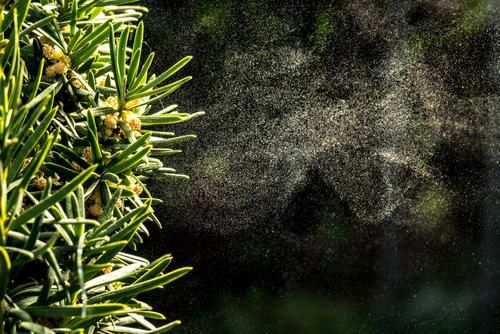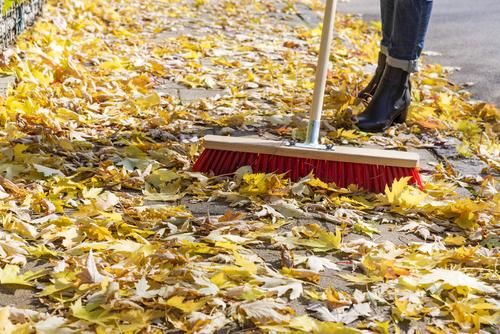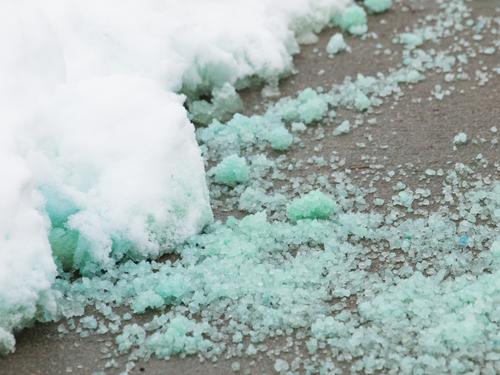Keeping your clients’ businesses clean under ordinary day-to-day circumstances can be challenging enough. However, the added difficulty involved in dealing with seasonal issues can make even the most experienced commercial cleaner blanch. From the challenges that salt and ice bring in the winter to dusting off all of the pollen in the spring, each season brings its own set of trials. Here is a brief overview of some of the things that will provide a unique challenge as well as a few tips on how to deal with them.
Spring
Fertilizers: Most landscaping companies will start to spread fertilizer around the grounds in the spring. It doesn’t matter if the fertilizer is slow-release or not, the composition is going to be the same: nitrogen, potash, and phosphate. These three chemicals affect concrete in different ways, attacking its structure. However, of those three, the nitrogen poses the most danger.
Nitrogen content causes ammonium nitrate to form. This works to dissolve the calcium hydroxide in the cement that binds the substrate together. While sealant will help protect the concrete, ammonium nitrate, as an acidic salt, will erode the sealant and reduce its effective life efficiently and quickly. To clean fertilizer and reduce the risk of damage to concrete, use a dry broom to clean surfaces and sweep the fertilizer
Pollen: Pollen is a challenge to clean in the spring and summer. Not only does it create an unsightly coating everywhere, cleaning the pollen is a challenge in itself. Using a traditional duster runs the risk of lifting the pollen into the air and redistributing it. In a commercial setting, this is undesirable because it will severely impact air quality as well as cause infiltration farther into the building.
Using a damp cloth and a wash bucket is the best way to remove pollen from most surfaces. Thankfully, pollen doesn’t travel far from entranceways so you shouldn’t have to worry about infiltration through the rest of the building.

Summer
Landscaping Debris: Summer may seem like it’s an easy time of the year; it being the time of vacations and long breaks. However, it also brings landscaping, which brings its own tribulations to cleaning office and industrial buildings. Grass clippings can stain flooring and carpets; tanbark and mulch bring wood fibers that can scratch flooring and damage carpet.
Make sure that when you’re cleaning this type of debris, your cleaners use a soft dry sweeping cloth or a soft-bristled broom. An enzymatic cleaner will help remove any grass stains from carpet or hard surface flooring.
Oil, Grease, and Food: Nothing says summer like picnics and hosting cookouts. Many businesses use these to increase employee morale or to draw in customers. As a commercial cleaner, you need to be aware of the challenges that these conditions present.
Extra care should be taken to ensure that all food debris is removed. If not, it will attract vermin and insects, which presents its own cleaning challenges. Oil and grease need to be cleaned appropriately, especially on smooth surfaces. Cleaning grease and residue from carpets may require special spot cleaning or a carpet cleaning regime outside of your normal schedule.
Autumn
Fall brings cooler weather and a welcome respite from the heat of summer. It also brings with it additional cleaning challenges. In areas with deciduous trees, this season brings gorgeous changes of colors as the leaves change from green to brilliant yellows and deep reds. Unfortunately, with these color changes, comes falling leaves.
Leaves and Other Debris: Individual leaves are unsightly, but en masse, they can cause a big cleaning headache. Left unattended on patios and other external areas, they will form damp masses that will work quickly to stain and damage concrete and other structures.
Your cleaning staff should work to remove leaves using a dust mop or broom quickly. Small branches and leaves will also scratch wax and finished surfaces, so their removal is paramount to prevent further work.
If the leaves should form a damp mass, your cleaning staff will need to use appropriate methods to clean and remove the debris. There will probably be residual staining and possibly damage to the underlying structure, depending on how long the leaves have been there. In this case, your customer should be informed so they can take steps in the spring to have the surface refinished.
Fertilizers: Fertilizers applied in the fall has higher nitrogen content than those applied in the spring. This means that it is even more important that your cleaners are able to remove any stray fertilizer from any concrete substrates. Again, be careful of using low-flow liquid to clean concrete, as this can cause the fertilizer to dissolve and stain the concrete. Use a dry broom with bristles to sweep the fertilizer pellets away from the concrete.

Winter
Winter brings with it one of the most difficult seasonal cleaning challenges for commercial cleaners. On top of ice, snow and other precipitation, you also have to deal with materials used to melt or provide slip-resistance.
Winter Precipitation: Excessive rain and other types of winter precipitation bring more than just slip hazards. While water and ice will not infiltrate sealed concrete, the freezing temperatures can damage the concrete by causing the moisture in the concrete binder to expand rapidly. This can lead to cracking or even buckling and lifting of the slabs.
Prompt removal of ice and snow from external surfaces will also help reduce the amount of slush that makes it into the building. Once precipitation makes it into the building, you’ll need it removed quickly from the entranceway before it can be tracked onto any carpeting. Use non-slip seasonal entryway mats and other temporary absorbent surfaces to keep your carpet dry. The use of entryway rugs will damage linoleum slightly, requiring stripping and waxing more frequently than normal.
Sand, Salt, and Grit: The primary challenge associated with sand, salt, and other non-slip materials is the damage they will do to interior surfaces. The heavier salts used as ice melt dissolve readily in water, allowing them to be tracked into businesses. These salts can then stain and discolor concrete and carpeting.

Removing the salt from hard surfaces is simple, only requiring that the cleaning staff use a fresh water and vinegar solution rinse. The mild acid of the vinegar will neutralize the salts, allowing it to be cleaned with a clean cloth. Before the solution is applied, the solid salts should be swept from the floor along with any other debris. The neutralizer should be allowed to rest on the floor for five to fifteen minutes before it is removed.
Chemical salt neutralizers can also be used to remove salt stains from carpet. However, the smell can be strong and should only be used after normal business hours. Setting up ventilation fans will help ensure that the carpet is dry before the start of business the next day.
Industrial cleaning has its own challenges no matter what the season. However, each season does bring in additional trials. As long as you are aware of what these are, you can ensure that your cleaning company is prepared to ensure that your business’ appearance doesn’t suffer just because of inclement weather or conditions.




0 comments